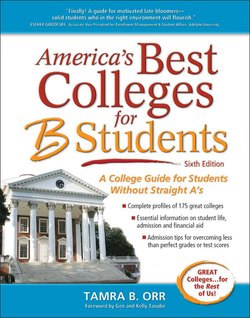Читать книгу America's Best Colleges for B Students - Tamra B. Orr - Страница 8
На сайте Литреса книга снята с продажи.
INTRODUCTION
ОглавлениеOnce upon a time, long, long ago, almost anyone who wanted to go to college and could find a way to afford it went to college. SAT just meant the past tense of “sit” and GPA was an odd combination of letters that might have been a neat abbreviation for “Grandpa.” After World War II, tests and test scores started to gain in importance, but it would be some time before they would become the determining factor behind going to college. Sure, if you had a great SAT score or a really high GPA, it was easier to get scholarships or get the really BIG colleges to give you more than a glance. But I remember applying to colleges without much thought at all about my numbers (I'm dating myself now, as that was back in the late 1970s). I was too busy scoping out the campus, checking the ratio of guys to girls and, oh yeah, seeing what majors were offered. (I must say, however, that 30 years later, I can STILL tell you my SAT scores.)
The picture is quite different today. Getting into college is not only more expensive but also much tougher. Colleges have become so selective that even valedictorians with a 4.0 average and perfect SAT scores are being turned away from some of the Ivy League institutions.
Because of this, many students are ready to throw their hands in the air and say, “Okay, I get it! I don't have good enough numbers, so I obviously can't go to college. I'll just forget it!” If you are among these, realize this: You, yes YOU, are the reason for this book. It is designed to give you two things: help with what it takes to get into many colleges (and an overview of what happens after you do) and leads on which colleges are eagerly awaiting your application.
For starters, get rid of the myths/assumptions you might have about choosing a college. If you believe any of the following, take them from the “The Earth is Round” list (truth) and put them in the “Santa Claus/Tooth Fairy” list (fantasies). Here we go:
You need a perfect GPA or SAT to get into a good college.
The best way to pick a college is by reading the rankings in a magazine article/taking your best friend's recommendation/choosing the names you recognize the most.
Traditional four-year colleges are the only ones employers will accept.
Only the large colleges are worth attending.
Your college should have more students than your high school does.
Small colleges offer inferior classes, faculty and degrees.
None of the above statements is true.
A perfect score or transcript is not required at most colleges, as you will see as you read this book.
The best way to select a college is to not accept someone else's opinion as absolute truth and to do your homework (yes, MORE homework) and find out which colleges best suit you and your preferences.
While four-year colleges are the norm, there are many two-year programs and other options that are just as appealing to future employers.
Small colleges often offer the conditions and student/teacher ratio that will ensure a high-quality, successful education. In no way are their classes, faculty or degrees inferior to those of the larger universities.
One of the biggest myths of all about college, of course, is that even if you find one that you like and will accept you, you will not be able to afford it. We will dispel that myth as well in Chapter Six.
You, standing right there in the middle of the library or bookstore (or at home scanning the intro because your parents told you, “READ THIS!”), you with the 2.9 or 3.1 GPA or the 1560 SAT score or 19 composite ACT, can go to a college or university. You can find yourself at a wonderful institution where you will make friends, have fun, grow up and yeah, learn a lot of stuff and get a degree. These colleges are not runners-up to the “good” places; they are wonderful schools that are willing to look beyond the numbers to the person standing behind them. They have admissions departments that give your scores some thought, and then put them down and search for the human being on the other side of the digits. And really, isn't that what you would want them to do anyway? You are certainly more than any group of numbers could possibly represent.
This book was written to guide you to lots of helpful information about 100 colleges and universities that want you to be a part of their student population. It will also show you how to:
Make the best use of the time you still have left in high school
Make a great impression on the college admissions department through both the essay and interview
Explain those less-than-stellar numbers and let your strengths shine through
Survive in college once you get there
Belonging is one of the strongest natural drives inside each and every person. You want to find a college where you are happy, comfortable and accepted. The administrations of these colleges want students who feel like they have found a new home. Let this book be your guide to that relationship.
